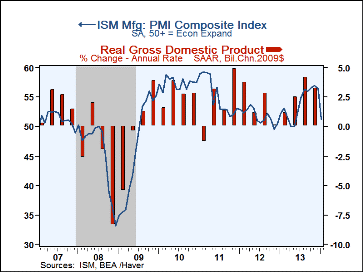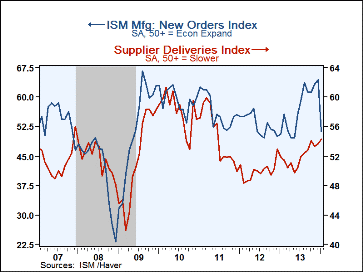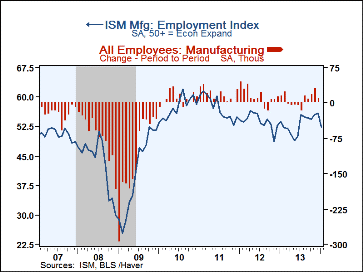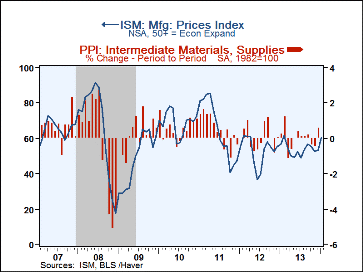 Global| Feb 03 2014
Global| Feb 03 2014U.S. ISM Index Plunges Under Heavy Weather
by:Tom Moeller
|in:Economy in Brief
Summary
Widespread snowstorms in the U.S. helped limit factory operations last month. The Composite Index of Manufacturing Sector Activity from the Institute for Supply Management dropped sharply to 51.3 during January from a revised 56.5 in [...]
Widespread snowstorms in the U.S. helped limit factory operations last month. The Composite Index of Manufacturing Sector Activity from the Institute for Supply Management dropped sharply to 51.3 during January from a revised 56.5 in December, initially reported as 57.0. Earlier figures were revised due to new seasonal factors. The latest reading was well below expectations for a slip to 56.0 as measured by the Action Economics Survey. Any figure above 50 indicates an increasing level of activity in the factory sector. During the last ten years, there has been a 76% correlation between the ISM index and the q/q change in real GDP.
A lower reading for new orders provided the greatest drag on last month's factory sector activity as it fell to 51.2 from 64.4. In addition, the production component fell to 54.8 from 61.7 and employment dropped to 52.3 from 55.8. During the last ten years there has been an 88% correlation between the employment index and the m/m change in factory payrolls. Inventories were drawn down at a faster rate as indicated by the lower inventory series. It fell to 44.0, the lowest level since December 2012. Finally, the supplier delivery series moved up to 54.3 indicating the slowest product delivery speeds since June 2011.
New export orders index fell to 54.5, the lowest reading since September while the order backlog reading dropped to 48.0, its lowest level since August. Imports declined to 53.5, the lowest level in twelve months.
The prices paid index series indicated further improvement in pricing power with a rise to 60.5, the highest level since February of last year. Twenty eight percent of firms raised prices while seven percent lowered them. During the last ten years there has been a 67% correlation between the index and the m/m change in the intermediate producer price index.
The figures from the Institute For Supply Management (ISM) are diffusion indexes and can be found in Haver's USECON database. The expectations number is in the AS1REPNA database.
Behind the Numbers: PCE Inflation Update, December 2013 from the Federal Reserve Bank of Dallas is available here.
| ISM Mfg | Jan | Dec | Nov | Jan'13 | 2013 | 2012 | 2011 |
|---|---|---|---|---|---|---|---|
| Composite Index | 51.3 | 56.5 | 57.0 | 52.3 | 53.9 | 51.8 | 55.2 |
| New Orders | 51.2 | 64.4 | 63.4 | 50.8 | 57.2 | 53.1 | 56.4 |
| Production | 54.8 | 61.7 | 62.4 | 53.8 | 57.7 | 53.8 | 57.4 |
| Employment | 52.3 | 55.8 | 55.4 | 53.8 | 53.2 | 53.8 | 57.4 |
| Supplier Deliveries | 54.3 | 53.7 | 53.3 | 51.9 | 51.9 | 50.0 | 54.7 |
| Inventories | 44.0 | 47.0 | 50.5 | 51.0 | 49.4 | 48.2 | 50.1 |
| Prices Paid Index (NSA) | 60.5 | 53.5 | 52.5 | 56.5 | 53.8 | 53.2 | 65.2 |
Tom Moeller
AuthorMore in Author Profile »Prior to joining Haver Analytics in 2000, Mr. Moeller worked as the Economist at Chancellor Capital Management from 1985 to 1999. There, he developed comprehensive economic forecasts and interpreted economic data for equity and fixed income portfolio managers. Also at Chancellor, Mr. Moeller worked as an equity analyst and was responsible for researching and rating companies in the economically sensitive automobile and housing industries for investment in Chancellor’s equity portfolio. Prior to joining Chancellor, Mr. Moeller was an Economist at Citibank from 1979 to 1984. He also analyzed pricing behavior in the metals industry for the Council on Wage and Price Stability in Washington, D.C. In 1999, Mr. Moeller received the award for most accurate forecast from the Forecasters' Club of New York. From 1990 to 1992 he was President of the New York Association for Business Economists. Mr. Moeller earned an M.B.A. in Finance from Fordham University, where he graduated in 1987. He holds a Bachelor of Arts in Economics from George Washington University.










